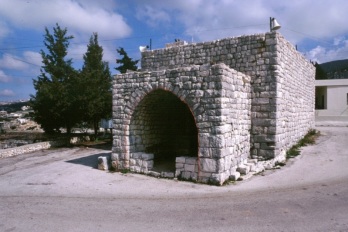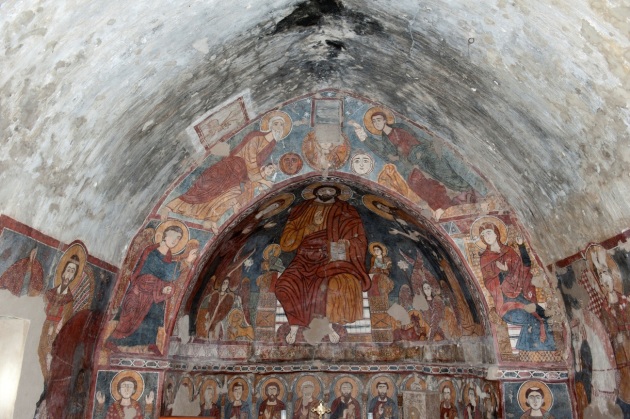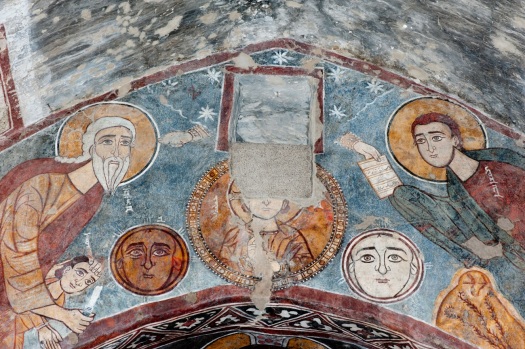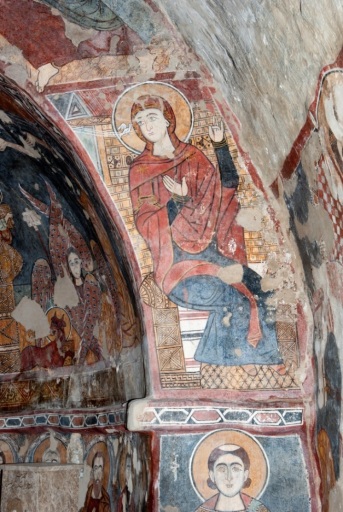Description and architectural analysis of the church of Mar Tadros

The road to the village of Behdidat snakes against the mountain-side overlooking several valleys. Several mediaeval vestiges betoken the presence of a significant Christian community. It is possible to spot, in a grove, the corniced apse of a small chapel dedicated to Mar Estphan (Saint Stephen), apostle and first martyr of the early Church. On the southern flank of the height, a vaulted porch, the walls of which exhibit traces of paint on either side of the sanctuary door lead to a small chapel with a semi-circular apse dedicated to Mar Nqoula (Saint Nicholas). Behind the altar of that building, at the centre of the apse's curve, a door opens into a second, more modest chapel dedicated to Saydet al-Bzez, Saint Mary the Nurturer. Two other sanctuaries unearthed by the Directorate General of Antiquities are currently screened by thickets blocking their access. To the north, some tens of meters from Mar Nqoula, stands Behdidat's parish church, Mar Tadros (Saint Theodore), the object of our study. It commands more attention because it lays bare the most ancient strata of devotion to its tutelary saint. Furthermore, a source mentions the ordination of its Syriac Orthodox priest in 1256. This text fills a gap in what is known of Ignatius III Sleeba the Maphrian shortly after his arrival in Tripoli and two years before his death. It confirms that the priest of Behdidat, Behnam son of Nu'man, priest, had been admitted into the clergy by the maphrian[1], himself.

The church of Mar Tadros closely adheres to the architectural features listed above. Its apse[2] further develops a pictorial programme, wherein Syriac inscriptions name the figures. The apse, the triumphal arch, semi-dome and surrounding spaces are covered with a complete pictorial programme, relating the story of Salvation in its two dimensions, according to the Old and the New Testaments under the aegis of two warrior saints: Saint George and Saint Theodore. The themes illustrated accord with the decisions taken at the second Council of Nicaea, in an inspiring display of their value for Christian devotion. The Book of Wisdom was pressed into service: “When people could not honour monarchs in their presence, since they lived at a distance, they imagined their appearance far away, and made a visible image of the king whom they honoured, so that by their zeal they might flatter the absent one as though present.” (Wis 14:17).


The painted figures decorating the Triumphal arch are set on either side of a ridge present in the original structure of the building. At the top of the arch the Christ Emmanuel is represented in a medallion the lower part of which alone survives. To the right and left of Christ two medallions show the sun and the moon “Who is she who looks forth as the morning/ Fair as the moon/ Clear as the sun/ Awesome as an army with banners?” (Song 6: 10). The theological tradition proposes an analogy between the church and the moon that reflects the radiant beauty of the sun as the church reflects the shining munificence of Christ in glory. Two scenes from the Old Testament complete the composition: to the left the sacrifice of Abraham: he wears a white tunic, his haloed head boasts a thick white hair, the bottom of his face is covered with a white beard and moustache. Abraham, his knife raised for the immolation of his son on the altar is interrupted in his gesture by the “divine hand” who saves Isaac as it is written in Genesis “Do not lay your hand on the lad, or do anything to him; for now I know that you fear God, since you have not withheld your son, your only son, from Me.” (Gen. 22: 12). That hand is seen emerging from the star-hemmed skylight to save the child Isaac who looks far ahead. Behind Abraham and Isaac, on the vault appears the ram “caught in a thicket by its horns” (Gen. 22:13). The Christian tradition sees in this episode a prefiguration of the Passion in which two images of Christ – as Isaac who is not sacrificed and as the ram who is – represent key tenets of the Christian faith. To the right, the second Old Testament scene shows a young beardless man with short black hair much taken with the divine gift of an unfolded parchment: Moses receiving the Tables of the Law: “And the Angel of the Lord appeared to him in a flame of fire from the midst of a bush. So he looked, and behold, the bush was burning with fire, but the bush was not consumed.” (Ex. 2: 3) Moses covers his hands with his tunic to receive the two “tablets of stone written with the finger of God” (Ex. 31:18) just like in a famous Sinai icon.


The lower parts of the Triumphal arch have Archangel Gabriel on the left bringing “good news” to Mary on the right, as written in the Gospel according to Luke: “Now in the sixth month the angel Gabriel was sent by God to a city of Galilee named Nazareth, to a virgin betrothed to a man whose name was Joseph, of the house of David. The virgin's name was Mary.... Then the angel said to her, ‘Do not be afraid, Mary, for you have found favour with God. And behold, you will conceive in your womb and bring forth a Son, and shall call His name Jesus'”. (L: 1: 26-27,30-31). Significantly placed at the entrance of the apse it expounds the Christian doctrine of salvation that sees in this event the moment when “God is made flesh” to save humanity. Mary, smaller in size, is shown sitting in profile, her body twisting around from left to right. A white dove flutters by her right ear. She makes “the purple and the scarlet” (Protev. James 12: 1) intended to weave a veil for the Lord's temple. This painting stages the virginal conception of Christ a theme that goes back to the Church Fathers[3]. Some of them – Gregory Thaumaturgus, John Chrysostom, Proclus of Constantinople – propounded a theory of the conception per aurem, possibly in reference to Psalm 45, entitled A Song of Love: “Kings' daughters are among /Your honorable women;/ At Your right hand stands the queen in gold from Ophir./ Listen, O daughter,/ Consider and incline your ear; /Forget your own people also, and your father's house;/ So the King will greatly desire your beauty;/ Because He is your Lord, worship Him. (Ps 45: 9-11)

On the left jamb of the Triumphal arch Prophet Daniel, wearing the traditional chlamys[4] stands in prayer, arms open to heaven. He is the seer who had announced the advent of the Son of Man. The opposite jamb shows Saint Stephen with a thurible; the first Christian martyr to have followed on the path of the Passion opened by Christ, he was the first to witness “the glory of God, and Jesus standing at the right hand of God” (Acts 7: 55). In the program of Mar Tadros, these two figures are framed in a red rectangle which makes them stand out and brings them closer to the worshipers.


Representation of Saint Stephen© Charles Chémaly
The whole semi-dome of the apse overlooking the altar is taken up by a Deesis[5]. Deeses are also to be found in six other churches in Lebanon Rashkida, Kfar Chleymane, Hai Saidet Qassouba, Saqiet el-Khait, Kaftoun, Kousba as well as Behdidat. Christ, enthroned sets on a purple cushion his feet on which sandals are indicated by a few lines. His right hand is held up in blessing, his left hand holds a book where an inscription can be read. Bowed towards him, right and left, hands outstretched, the Virgin and Saint John the Baptist beg his mercy for humankind. Four haloed figures frame the throne: the four symbols of the evangelists – the tetramorphs[6]. Inscriptions in Syriac indicate their names: Matthew, Mark, Luke and John.





On either side of the throne, hexapterygon (six-winged), a cherub[7] and a seraph[8], – the latter, to the right, identifiable at the countless eyes inserted in his feathers carries a signboard on which “Qodesh” is written three times in Estrangelo[9] . The scene alludes to to Isaiah 6: 1-3: “In the year that King Uzziah died, I saw the Lord sitting on a throne, high and lifted up, and the train of His robe filled the temple. Above it stood seraphim; each one had six wings: with two he covered his face, with two he covered his feet, and with two he flew. And one cried to another and said: ‘Holy, holy, holy is the Lord of hosts;/ The whole earth is full of His glory!'”. This composition also echoes the vision described in the Book of Revelation attributed to John the Apostle.

The lower part of this first register in the semi-dome is underscored by a freeze of geometric cum floral patterns. The Deesis is, as it were, underpinned by an apostolic college of “twelve witnesses”. Twelve figures whose haloes, thinly outlined in black, are espoused by a painted horse-shoe arch supported by thin columns with plain capitals. Only some of the figures are identified by an inscription in Syriac. The position of each apostle in this register fairly observes popular canons, to wit: the two pillars of the church, Peter and Paul stand at the centre of the composition. The former sports a rounded beard and curly white hair; a part of his left hand shows beneath a black spot where there was a scroll. The latter bald-headed, his beard black and pointy-shaped, holds a Gospel to his chest. The four evangelists are set on either side among the apostles. To Peter's right: Mark, Luke, Andrew, Thomas and Bartholomew. To Paul's left: John, Matthew, James and Philip. In Behdidat, John is represented as a beardless youth, contrary to the old man with the large balding forehead of the Byzantine archetype. Like Peter and Paul, every figure holds a white, rolled-up scroll. Their stance invites a direct connection with the worshippers.

On the walls of the nave boast two large panels only guide towards the apse. North, in a Roman soldier's garb (armour, chainmail, a slander lance and a shield decorated with polychrome stripes) Saint Theodore, patron saint of the church, rides a brown horse. Underfoot the shape of a deleted figure: the donor. On the Eastern flank a frontal figure of Saint George[10] astride a white horse above a blue tide swarming with red fish; he holds a lance in his right hand and a bridle in the left and wears a red cloak. He has behind him a child with a chalice in his right hand and an ewer in his left: the Youth of Mytilene who, according to legend, was posthumously saved from slavery by the Saint, while the King's daughter he rescued from the dragon is seen below the horse. Underfoot lay the donor. Astride their horses, Theodore and George, the two warrior-saints, fight embodiments of evil forces and contribute to Christ's victory.


South, North and West the walls are scattered with crosses of Lorraine set in rectangular frames in red.








